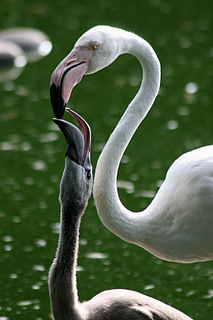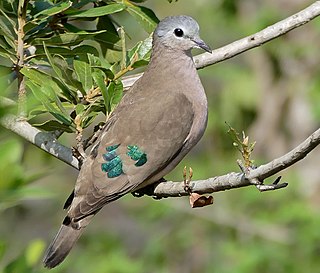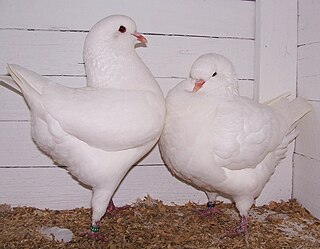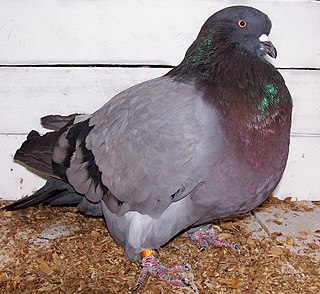
Poultry are domesticated birds kept by humans for their eggs, their meat or their feathers. These birds are most typically members of the superorder Galloanserae (fowl), especially the order Galliformes. The term also includes birds that are killed for their meat, such as the young of pigeons but does not include similar wild birds hunted for sport or food and known as game. The word "poultry" comes from the French/Norman word poule, itself derived from the Latin word pullus, which means small animal.

The rock dove, rock pigeon, or common pigeon is a member of the bird family Columbidae. In common usage, this bird is often simply referred to as the "pigeon".
Squib or Squibb may refer to:

The mourning dove is a member of the dove family, Columbidae. The bird is also known as the American mourning dove, the rain dove, and colloquially as the turtle dove, and was once known as the Carolina pigeon and Carolina turtledove. It is one of the most abundant and widespread of all North American birds. It is also a leading gamebird, with more than 20 million birds shot annually in the U.S., both for sport and for meat. Its ability to sustain its population under such pressure is due to its prolific breeding; in warm areas, one pair may raise up to six broods of two young each in a single year. The wings make an unusual whistling sound upon take-off and landing, a form of sonation. The bird is a strong flier, capable of speeds up to 88 km/h (55 mph). It is the national bird of the British Virgin Islands.
Pigeon is a common name for birds of the taxonomic family Columbidae, particularly the rock pigeon.

A dovecote or dovecot, doocot (Scots) or columbarium is a structure intended to house pigeons or doves. Dovecotes may be free-standing structures in a variety of shapes, or built into the end of a house or barn. They generally contain pigeonholes for the birds to nest. Pigeons and doves were an important food source historically in the Middle East and Europe and were kept for their eggs and dung.

Crop milk is a secretion from the lining of the crop of parent birds that is regurgitated to young birds. It is found among all pigeons and doves where it is referred to as pigeon milk. An analog to crop milk is also secreted from the esophagus of flamingos and the male emperor penguin.

The domestic pigeon is a pigeon subspecies that was derived from the rock dove. The rock pigeon is the world's oldest domesticated bird. Mesopotamian cuneiform tablets mention the domestication of pigeons more than 5,000 years ago, as do Egyptian hieroglyphics. Research suggests that domestication of pigeons occurred as early as 10,000 years ago.

Pigeon keeping or pigeon fancying is the art and science of breeding domestic pigeons. People have practised pigeon keeping for about 10,000 years in almost every part of the world. In that time, humans have substantially altered the morphology and the behaviour of the domesticated descendants of the rock dove to suit their needs for food, aesthetic satisfaction and entertainment.

The emerald-spotted wood dove is a bird of the family Columbidae, resident across eastern and southern Africa. It is a species of open drier deciduous woodland and second growth. It is absent from evergreen rainforests and semidesert areas.

In culinary terminology, squab is a young domestic pigeon, typically under four weeks old, or its meat. The meat is widely described as tasting like dark chicken. The term is probably of Scandinavian origin; the Swedish word skvabb means "loose, fat flesh". It formerly applied to all dove and pigeon species, such as the wood pigeon, the mourning dove, the extinct-in-the-wild socorro dove, and the now-extinct passenger pigeon, and their meat. More recently, squab meat comes almost entirely from domesticated pigeons. The meat of dove and pigeon gamebirds hunted primarily for sport is rarely called squab.

Utility pigeons are domesticated pigeons bred to be a source of meat called squab. Squabs have been used as a food in many nations for centuries. They were bred to breed and grow quickly. Because they are bred for squab production, conformation to a show standard is usually deemed unimportant.

The Strasser is a breed of fancy pigeon developed over many years of selective breeding. Strassers, along with other varieties of domesticated pigeons, are all descendants from the rock pigeon . Apart from exhibition at pigeon shows, the breed is also used for utility purposes for producing squabs as food.

The King is a breed of pigeon developed over many years of selective breeding primarily as a utility breed. Kings along with other varieties of domesticated pigeons are all descendants from the rock pigeon . The breed is known for large size and suitability for squab production.

The Carneau is a breed of pigeon developed over many years of selective breeding primarily as a utility pigeon. Carneau, along with other varieties of domesticated pigeons, are all descendants from the rock pigeon . The breed is known for large size and suitability for squab production. White Carneau pigeons are extensively used in experiments on operant conditioning; most of the pigeons used in B. F. Skinner's original work on schedules of reinforcement were White Carneaux.

The Giant Runt is a breed of pigeon developed by selective breeding primarily as a utility and exhibition breed. American Giant Runts, along with other varieties of the domestic pigeon, are all descendants from the rock pigeon . The breed is known for its large size and suitability for squab production.

The Pigeon That Took Rome is a 1962 film directed and written by Melville Shavelson and starring Charlton Heston. The film is a comedy set in World War II and was based on the 1961 novel The Easter Dinner by former spy Donald Downes.

Squab pie is a traditional dish from South West England, with early records showing it was associated with Cornwall, Devon and Gloucestershire. Although the name suggests it contains squab, in fact it contains mutton and apples. The pie was eaten around the world in the 1900s, though outside South West England it generally did contain pigeon.

Pigeon pie is a savoury game pie made of pigeon meat and various other ingredients traditional to French cuisine and present in other European cuisines. It has been eaten at least as early as 1670 in French cuisine.
















